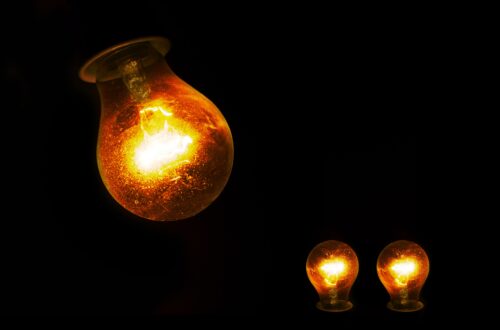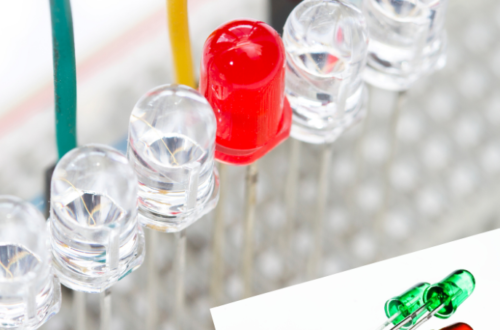What is SMART Lighting?
What is SMART lighting and do I need it?

Is it Smart or not?
Whether you’re a real gadget lover (like me!) or a total technophobe, you’ve probably heard about ‘intelligent’ or SMART lighting. But what is it and what can it do for you?
The whole Smart home concept can be a bit overwhelming when you are just starting out – and a bit pricey too! I’m going to tell you what these bright little devices can do. So you can decide whether you need smart technology in your home, garden, or life!
“In technology terms SMART stands for “self-monitoring, analysis, and reporting technology. Smart lighting is a lighting technology designed for energy efficiency. This may include high efficiency fixtures and automated controls that make adjustments based on conditions such as occupancy or daylight availability.”
wiki open source ecology
At a glance
- Energy saving
- Mood enhancing
- Extra security
- Advanced connectivity
- Infinite controllability
- Millions of colours
- Automated controls
- Disadvantages
Energy saving
Ok. So you could say that any LED bulb is energy saving. And whilst this is true, when an LED bulb becomes a smart bulb it can be so much more.
Apart from the usual advantages of LED bulbs, such as being long lasting and energy efficient, smart LEDs can save you even more money if used to their full potential. With smart bulbs you have total control over the brightness, meaning you can use just as much light as you need. Using less light means lower running costs, without having to buy expensive dimmer switches.
In addition to brightness control, smart bulbs also give you total control over scheduled lighting. You can program lights to come on and off automatically whenever you like, as many times as you like. So no need to leave the porch light on all day because you are going to get home late and can’t find your keys in the dark.
You could also set a program to turn off lights that are still switched on after a certain time. For example, that sitting room corner lamp you forgot to turn off when you went to bed and was left on all night.
Mood enhancing
Probably my favourite of all the features offered by smart lighting is the ability to change the ambience of a room at the touch of a button. Or as I usually do, by saying a chosen voice command to your virtual assistant. When I say change the ambience, or feel of the room, I’m not just talking about dimming the lights while you snuggle down to watch a romantic movie together. I’m talking about way more than that!
Just imagine, in a split second you can change every light fitting and lamp in your living room. From everyday, soft, white lighting to energising daylight white to get you in the mood for writing an essay or to concentrate on a jigsaw puzzle. Alternatively you could have all the lights suddenly glow a gentle warm orange, as if surrounded by candlelight. You could even colour-match the lighting to support your favourite sports team while you watch the game. Or how about setting each light to a different vibrant colour for an evening with friends, a few drinks and dancing?
The possibilities are endless and only limited by your imagination.
Check out the ambience with the cool Philips Hue Smart Lighting Simulator
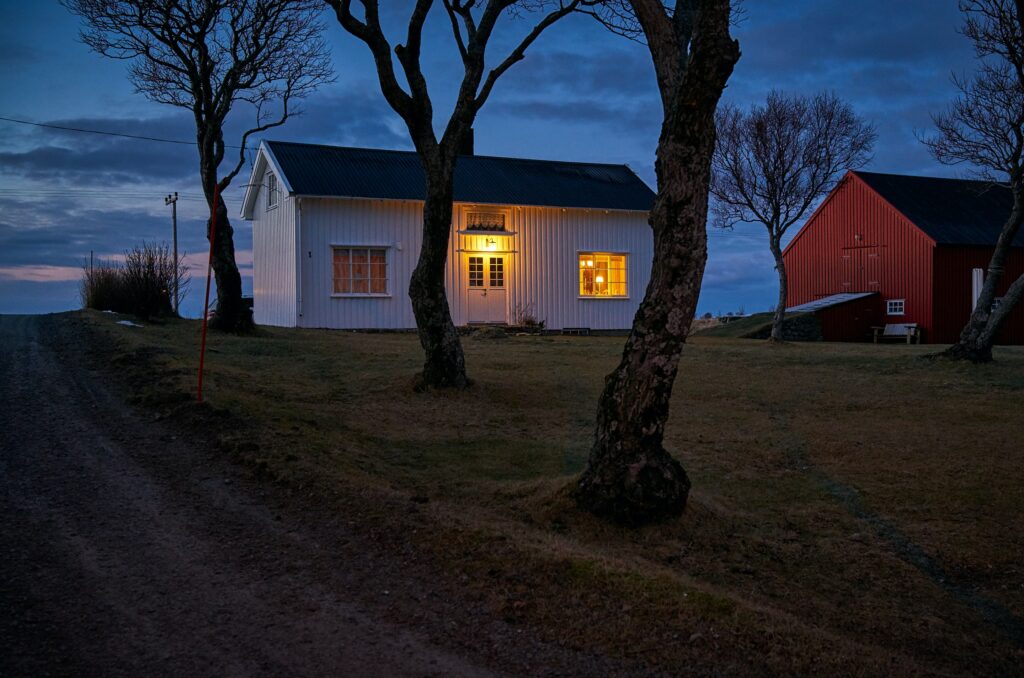
Extra Security
Who doesn’t leave a lamp on when they go out, to make it look like someone is at home? I used to and I know a lot of people who do (my Dad included). But with smart technology you can take it a step further to help keep your home secure.
Smart lights can be set up so that any number of lights automatically switch on and off at set times to make it seem as if someone is home when you are away. In fact, some lighting control systems even have a random ‘away setting’ for this very reason. And if you are unexpectedly away from home, without setting an automated schedule, then you can simply turn on the lights using your mobile device – from anywhere in the world!
Furthermore, most smart lighting systems can be used in conjunction with other devices, such as motion sensors and cameras. So you can feel completely relaxed and stress-free when you’re away on holiday or staying with friends.
Advanced connectivity
With many smart LEDs you have advanced options available to connect them to other WiFi or Bluetooth-enabled devices, for even more amazing features. You might think that you don’t need any more options, but just imagine having the lights flash and strobe in time to your favourite music? Or for the hard of hearing, lights that flash red when someone rings the doorbell? You could even set a lamp to flash when the time is up for the cake you are baking in the oven.
This is my personal favourite. You’re watching your favourite sci-fi movie and all the lights around you are seamlessly synchronised with what’s happening on the screen! And not just colour-synchronised, but actually in perfect placement according to what’s on the screen and where. So, a red lightsabre strikes across the bottom left corner of your TV screen and simultaneously, the little table lamp over your left shoulder instantly glows red – split second, perfect timing. It doesn’t get much more immersive than that – and it’s brilliant for gaming too!
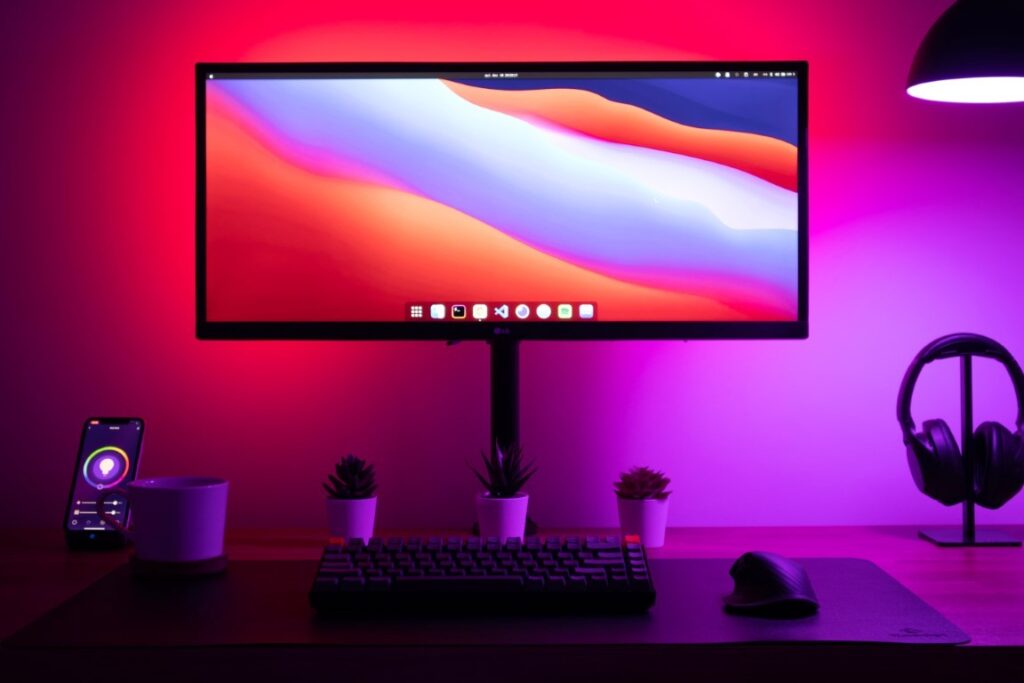
See how Smart lighting can sync with your TV or gaming monitor
Infinite controllability
It’s useless having all this technology and features if you can’t control exactly how you want it. But luckily you can and in just about any way you want.
Most people prefer to use a mobile device app because this gives advanced controls and settings right in the palm of your hand. You can also use a smart speaker – Apple Alexa or Google Siri, etc. – with simple voice commands, wireless remote controls, and tiny smart buttons. You could even have a wall mounted mobile device as a dedicated home technology control centre.
Millions of colours
Some smart bulbs can quite literally be set to any one of millions of different colours. The Philips Hue range of coloured bulbs and LED strips proudly advertise an incredible 16 million different colours to choose from, with 50,000 different shades just for white! Maybe that’s a little bit OTT, but do you can see what I’m getting at? All those colours at your fingertips – you could create a different colour scheme for every single room in a 20 storey block of 3 bedroomed apartments, for multiple times of the day and still have some colours left over. Would anyone like to volunteer to do the maths to prove that I’m right?
Automated control
Being able to program an automatic schedule for your lights is a great feature, but why stop at switching lights on and off twice a day?
So many smart light systems can be set to advanced programs such as coming on automatically at dusk, or if you link to your mobile’s GPS tracking system, they will turn off automatically as soon as you leave the perimeter of your property. And back on again when you are within range. Just imagine your garden or porch lights switching on automatically as soon as you approach your driveway! How cool would that be? You can also sync your lights with other smart devices, e.g. smart plugs and doorbells, and even program automated sequences that combine multiple devices and responses.
Let me give you a few voice control examples that I have quickly thought up. But seriously, the possibilities for automated control and programmable schedules are absolutely endless.
- ‘Good Morning’ – your smart speaker can respond by telling you the weather forecast, or today’s news headlines, whilst simultaneously switching on the room lights and the coffee machine in the kitchen!
- Say ‘it’s movie time’ and instantly your smart window blind begins to close, your entertainment system comes to life, tv switches on and your favourite movie theme plays in the background. Let’s go the whole hog and heat-up the popcorn machine as well.
- It’s bedtime. Say ‘Goodnight’ and you can listen to reminders for tomorrow’s appointments, turn off any smart plugs, switch on the hallway lights to go to bed. Play some soothing sleep music and then switch off bedroom lights after a few minutes, when you are all cosily tucked up in bed.
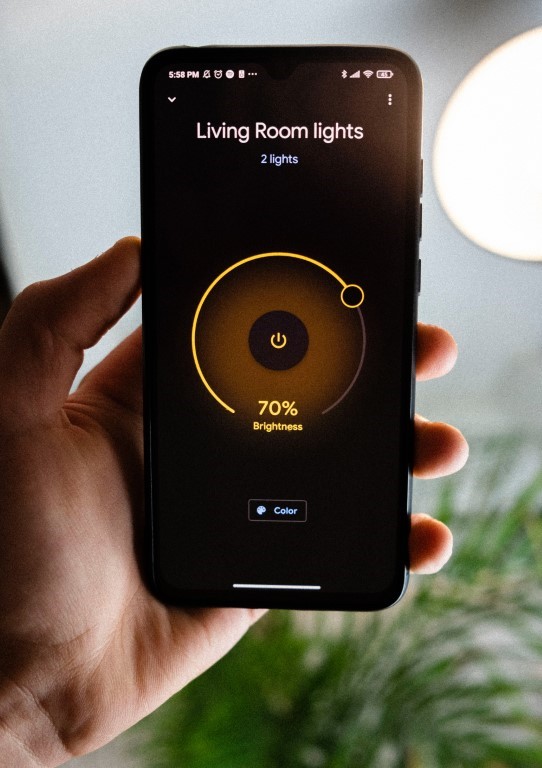
Disadvantages of Smart Lighting
As with most things, there can also be downsides to intelligent lighting technology too.
Smart lighting can be expensive to set up, but don’t try and save money buying less well-known brands. That could cause you more costlier problems in the long run. For a top brand like Philips Hue you can expect to pay up to 50€ for a single bulb! However, big savings can be made if you buy multiple item kits, other more affordable brands, or just wait for some money-off deals to pop up.
It’s important to remember that all smart devices are practically useless if you don’t have a reliable WiFi connection. And whilst some devices can work from Bluetooth alone, the majority of smart devices rely on a consistently stable WiFi connection. So if you have a reliable internet provider then you shouldn’t have any problems. But just bear in mind that a lot of features won’t be available if your WiFi goes off, as it occasionally does in the more rural locations in France.
Love your apps? Then you need Smart Lighting!
So, if you love your gadgets, want some ultra-cool features around the home (or office) and don’t mind playing around, setting up apps and multiple devices. Then you need some Smart lighting technology in your life!
Owen Duggan
LuxSabre – the art of illumination



